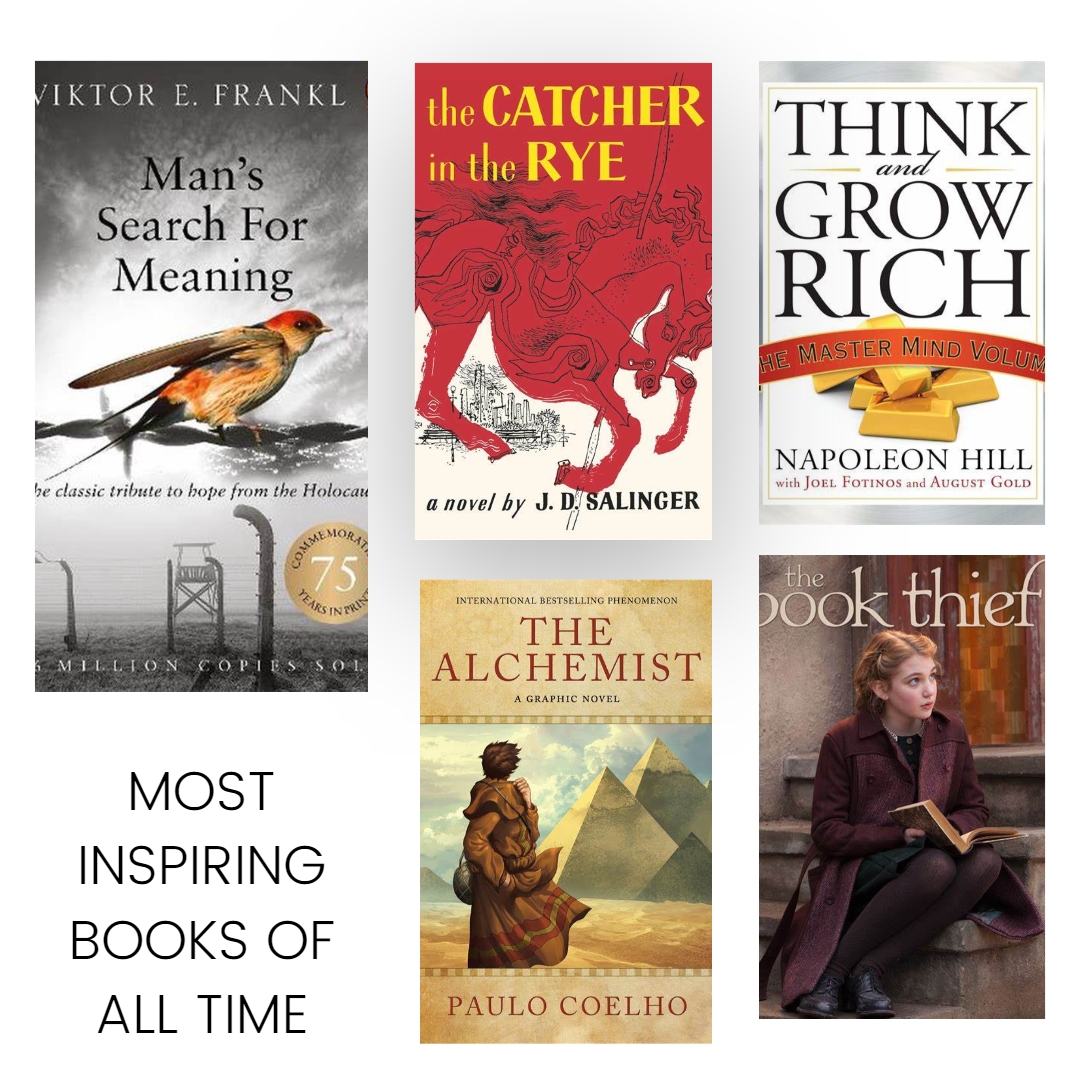Are you looking for “The Most Inspiring Books of All Time”? You have landed in the right place.
If you have log in to any bookstore or amazon to find out inspiring books, you trapped to see lots books.
Our article will enable you to find the most inspiring books, topics specially for you. This article will help you to improve your attitude and help in finding your dreams through great books.
We are giving you complete step by step details and excerpts of the books.
- “The Alchemist” by Paulo Coelho
- “To Kill a Mockingbird” by Harper Lee
- “The Power of Now” by Eckhart Tolle
- “Man’s Search for Meaning” by Viktor E. Frankl
- “The Great Gatsby” by F. Scott Fitzgerald
- “The Little Prince” by Antoine de Saint-Exupéry
- “Pride and Prejudice” by Jane Austen
- “The Catcher in the Rye” by J.D. Salinger
- “The Diary of a Young Girl” by Anne Frank
- “Think and Grow Rich” by Napoleon Hill
- “The Book Thief” by Markus Zusak
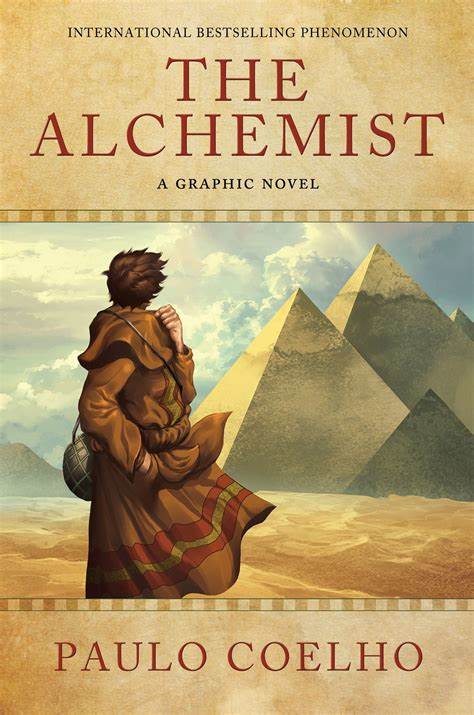
1. The Alchemist
“The Alchemist” by Paulo Coelho finds its place in this list of inspiring books due to its profound exploration of personal destiny, dreams, and the journey of self-discovery. The book follows the story of Santiago, a shepherd boy, as he embarks on a quest to find his “Personal Legend” – his unique purpose in life.
Read More – The Alchemist by Paulo Coelho -Most Inspiring Book of All Time
Read More – 10 Most Inspiring Quotes from -The Alchemist

2. The Power of Now
“The Power of Now” by Eckhart Tolle is included in the list of inspiring books because of its profound insights into mindfulness, presence, and the transformation of one’s consciousness. The book explores the concept of living in the present moment and shedding the burdens of past regrets and future anxieties. Here’s why “The Power of Now” is considered an inspiring read.
1. Mindfulness and Presence: “The Power of Now” teaches readers to shift their focus away from dwelling on past mistakes or worrying about the future. Tolle emphasizes the importance of living in the present moment to find true contentment and peace.
2. Liberation from Mental Patterns: The book encourages readers to break free from the habitual thought patterns and negative emotions that can cause suffering. Tolle provides practical guidance on how to observe thoughts without getting entangled in them.
3. Overcoming Ego: Tolle discusses the concept of the ego and its role in creating suffering. He guides readers toward recognizing the ego’s influence and finding a deeper sense of self beyond it.
4. Inner Stillness: The book explores the idea of finding inner stillness and quieting the constant mental chatter. This inner stillness is where true clarity and creativity can arise.
5. Embracing Acceptance: Tolle emphasizes the importance of accepting the present moment as it is, without resistance or judgment. This acceptance leads to a greater sense of peace and understanding.
6. Transcending Time: By learning to detach from the continuous stream of thoughts related to past and future, readers can experience a sense of timelessness and presence.
7. Personal Transformation: “The Power of Now” offers readers a path to personal transformation and spiritual awakening. It provides tools to break free from limiting beliefs and habitual behaviors that hinder growth.
8. Universal Wisdom: Tolle draws from a variety of spiritual traditions and teachings, making the book accessible to readers of different backgrounds and beliefs.
Overall, “The Power of Now” is considered inspiring because it offers practical insights into cultivating mindfulness, finding inner peace, and experiencing life more fully. Its teachings encourage readers to shift their perspective, embrace the present moment, and embark on a journey of self-discovery and personal transformation.
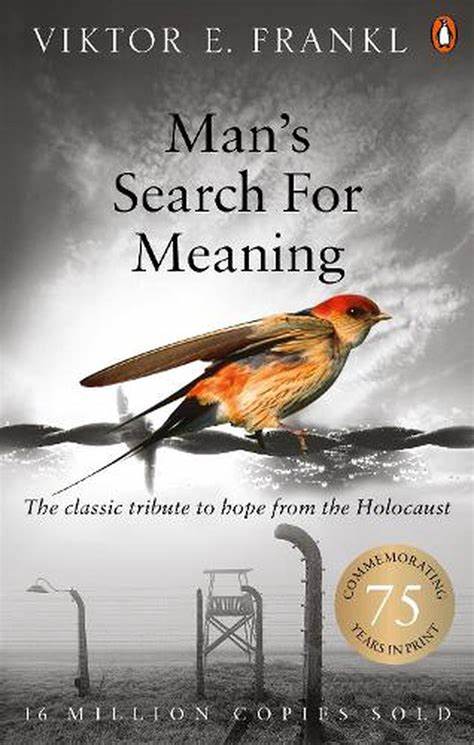
3. Man’s Search for Meaning
“Man’s Search for Meaning” by Viktor E. Frankl is included in the list of inspiring books due to its profound exploration of the human capacity to find meaning and purpose even in the face of extreme suffering. The book is a testament to resilience, hope, and the indomitable human spirit. Here’s why “Man’s Search for Meaning” is considered an inspiring read:
1. Triumph Over Adversity: The book chronicles Viktor Frankl’s experiences as a Holocaust survivor, detailing the horrors he endured in Nazi concentration camps. Despite the immense suffering, the book underscores the human ability to find meaning and maintain a sense of dignity even in the darkest of circumstances.
2. Search for Purpose: Frankl introduces the concept of “logotherapy,” which emphasizes the importance of finding meaning in one’s life. He argues that individuals can endure almost anything if they have a compelling reason to do so.
3. Inner Freedom: Through his personal experiences, Frankl demonstrates that even when external circumstances are beyond one’s control, individuals possess the inner freedom to choose their attitude and response to those circumstances.
4. Resilience and Hope: “Man’s Search for Meaning” exemplifies the incredible resilience of the human spirit. Frankl’s determination to find meaning and his belief in the potential for positive change serve as a source of hope and inspiration.
5. Transcending Suffering: The book challenges readers to consider the power of their minds and their ability to rise above suffering. Frankl’s message is that even in the face of unimaginable hardship, humans can transcend their circumstances by finding purpose and inner strength.
6. Universal Relevance: While rooted in Frankl’s experiences during the Holocaust, the book’s insights are universally applicable. It speaks to the human condition, the quest for meaning, and the potential for transformation.
7. Psychological Insights: Frankl, a psychiatrist, offers psychological insights into the human psyche. His observations about the interplay between suffering, meaning, and mental health provide readers with a new perspective on their own challenges.
8. Practical Wisdom: The book provides practical guidance on how to discover and cultivate meaning in life, offering readers tools to navigate their own struggles and uncertainties.
Overall, “Man’s Search for Meaning” is an inspiring book because it demonstrates the extraordinary resilience of the human spirit in the face of unimaginable suffering. Through Frankl’s powerful narrative and philosophical reflections, readers are invited to reevaluate their own lives, find purpose, and discover the strength to endure and flourish even in difficult circumstances.
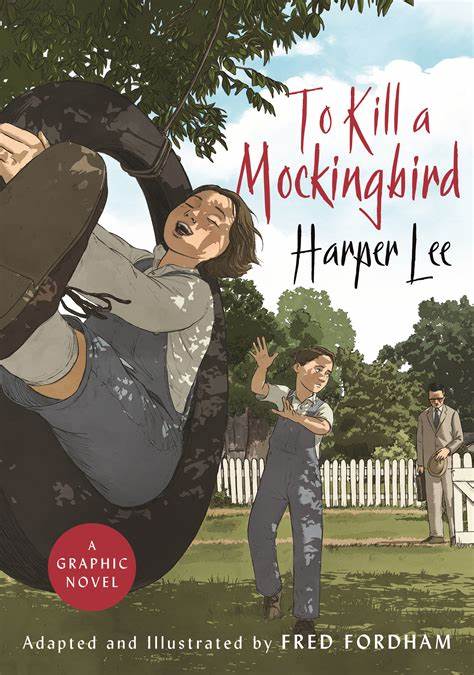
4. To Kill a Mockingbird
“To Kill a Mockingbird” is a classic novel written by Harper Lee, first published in 1960. It is set in the racially segregated town of Maycomb, Alabama, during the 1930s and tells the story of Scout Finch, a young girl, and her experiences growing up in a racially charged and morally complex society.
Here are some key insights into “To Kill a Mockingbird”:
1. Themes of Racism and Injustice: At the heart of the novel is a powerful exploration of racism and injustice. The story revolves around the trial of Tom Robinson, a Black man falsely accused of raping a white woman, Mayella Ewell. The novel sheds light on the deep-seated racial prejudice and discrimination that existed in the American South during this period.
2. Moral Growth and Empathy: The novel follows Scout Finch’s journey from childhood innocence to a deeper understanding of the complexities of the world around her. Through her father, Atticus Finch, she learns important lessons about empathy, tolerance, and the importance of standing up for what is right, even in the face of societal pressure.
3. Atticus Finch: Atticus, Scout and Jem’s father, is one of the central figures in the novel. He is a principled and compassionate lawyer who defends Tom Robinson in court, knowing that the odds are stacked against him. Atticus serves as a moral compass, teaching his children valuable lessons about justice, integrity, and the importance of respecting all individuals.
4. The Mockingbird Symbolism: The novel’s title is a reference to the idea that it is a sin to harm innocent beings, just as it is a sin To Kill a Mockingbird. Mockingbirds, in this context, symbolize those who are vulnerable and harmless. Tom Robinson and Boo Radley are two characters who can be seen as “mockingbirds” in the story, as they are misunderstood and mistreated by society.
5.Small-Town Life: Lee captures the essence of small-town life in the American South, with its complex social hierarchies, gossip, and interconnected relationships. Maycomb serves as a microcosm of the broader issues of racism and inequality that were prevalent in the region during the era of Jim Crow laws.
6. Narration and Perspective: The novel is narrated from Scout’s perspective, offering a child’s-eye view of the events and characters. This perspective allows readers to witness the gradual awakening of moral consciousness in Scout as she navigates the challenges of her environment.
“To Kill a Mockingbird” is not only a powerful exploration of racial injustice but also a timeless story about the complexities of human nature, the importance of empathy, and the enduring struggle for equality and justice. It continues to be a widely studied and cherished work of literature that resonates with readers of all ages.
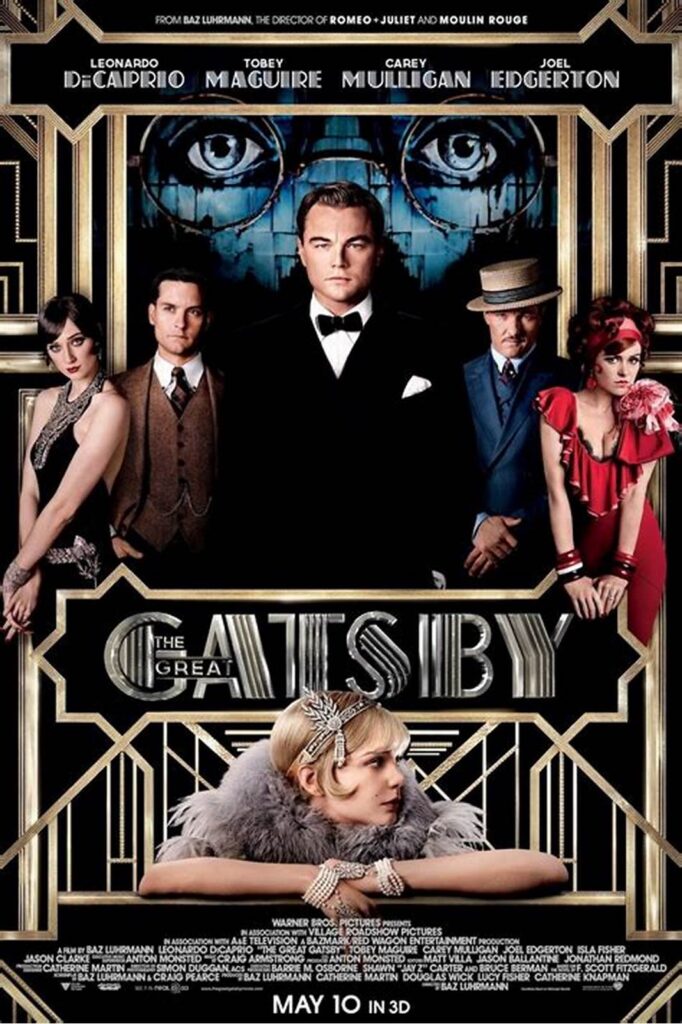
5. The Great Gatsby
“The Great Gatsby” is a classic novel written by F. Scott Fitzgerald and published in 1925. Set during the Roaring Twenties, the novel is a tale of love, wealth, decadence, and the American Dream.
1. The American Dream: The novel explores the idea of the American Dream, which is the belief that anyone, regardless of their background, can achieve success and prosperity through hard work and determination. Jay Gatsby, the enigmatic millionaire at the center of the story, embodies the pursuit of this dream as he amasses wealth in the hope of winning back his lost love, Daisy Buchanan.
2. Social Stratification: Fitzgerald portrays a society divided by wealth and social class. The characters in the novel are often categorized into “old money” (those born into wealth) and “new money” (those who have acquired wealth in their lifetime). The stark contrast between these two groups highlights the shallowness and moral decay of the upper class.
3. The Roaring Twenties: “The Great Gatsby” is set in the 1920s, a period of great economic prosperity and social change in America. The novel captures the excesses of the era, including lavish parties, conspicuous consumption, and the pursuit of pleasure.
4. The Green Light: The green light at the end of Daisy’s dock is a recurring symbol in the novel. It represents Gatsby’s unattainable dreams and desires. He stares at the green light across the bay, believing it to be a beacon of hope and possibility, much like the American Dream itself.
5. Love and Obsession: The love story between Gatsby and Daisy is central to the novel. Gatsby’s unwavering love and obsession with Daisy drive much of the plot. His belief in the possibility of recapturing the past and rekindling their romance is a poignant theme.
6. Tragedy and the Fall of the American Dream: As the story unfolds, it becomes clear that the pursuit of the American Dream, as depicted in the novel, often leads to disillusionment, tragedy, and moral decay. Gatsby’s downfall serves as a cautionary tale about the hollowness of the dream itself.
“The Great Gatsby” is a complex and beautifully written novel that continues to be studied and celebrated for its exploration of the American Dream, the excesses of the Jazz Age, and the enduring themes of love, illusion, and the human condition. It remains one of the most important works of American literature.
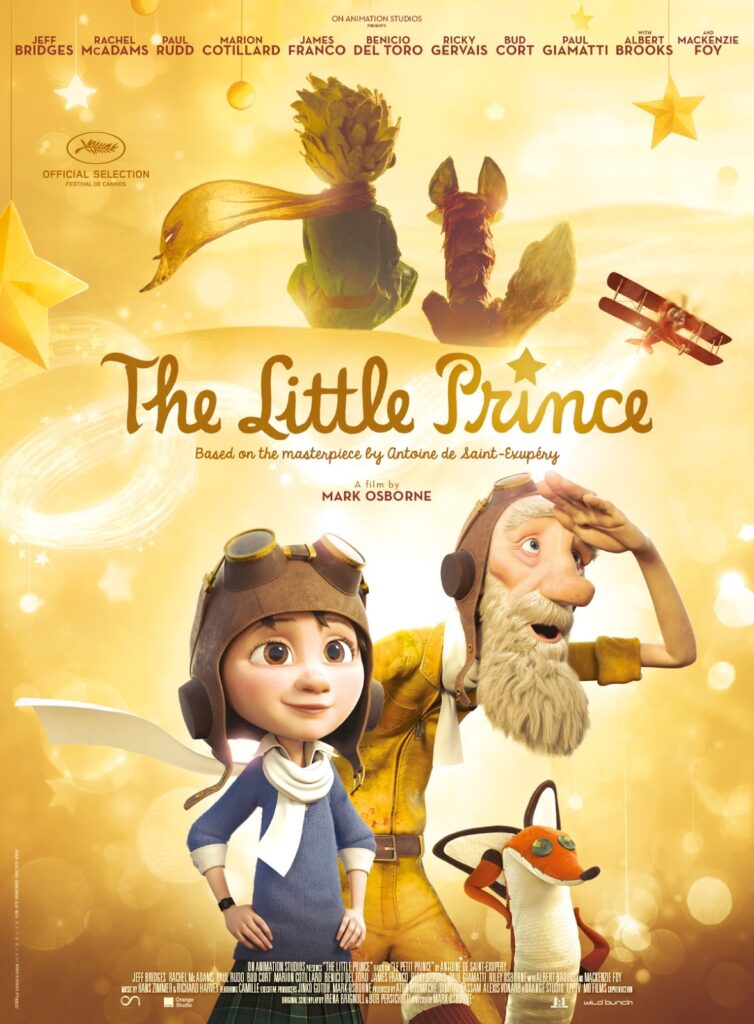
6. The Little Prince
“The Little Prince” (original title: “Le Petit Prince”) is a novella written by Antoine de Saint-Exupéry, a French writer and aviator. It was first published in 1943 and has since become one of the most translated and beloved books in the world.
Here are some insights into “The Little Prince”:
1. Philosophical Allegory: “The Little Prince” is often categorized as a children’s book, but it is also a philosophical allegory that explores profound themes of love, friendship, human nature, and the search for meaning in life. The story is both simple and deeply meaningful, making it accessible to readers of all ages.
2. The Little Prince: The story is narrated by a pilot who crashes his plane in the Sahara Desert and encounters a young prince from another planet, the titular Little Prince. The Little Prince is on a journey to explore other worlds, but through his encounters with various characters, he learns valuable life lessons.
3. The Importance of Imagination: The Little Prince encourages readers to see the world through the eyes of a child, emphasizing the importance of imagination and creativity. He values the beauty and wonder of everyday things that adults often overlook.
4. Social Critique: Throughout his travels, the Little Prince visits different planets, each inhabited by a single adult who exhibits various flaws and absurdities. These encounters serve as a critique of adult behavior and priorities, highlighting the importance of retaining a childlike perspective on life.
5. Rose and Love: The Little Prince’s love for a single rose on his home planet is a central theme. His relationship with the rose represents the complexities and challenges of love, including jealousy, longing, and sacrifice. Their relationship mirrors human relationships and the efforts we put into them.
6. Fox and Friendship: The Little Prince forms a deep friendship with a fox on Earth. The fox imparts wisdom about the nature of human connections, emphasizing the value of taming (getting to know) others and the importance of time and commitment in building relationships.
7. The Search for Meaning: The novella raises questions about the nature of existence and the search for meaning in life. It encourages readers to reflect on their own lives and priorities.
8. Lessons for Adults: While the book is often seen as a fable for children, it contains valuable lessons and insights for adults as well. It challenges grown-ups to reevaluate their priorities, rediscover their sense of wonder, and cultivate meaningful relationships.
“The Little Prince” is a timeless and poignant story that continues to resonate with readers around the world. Its enchanting narrative and profound themes make it a work of literature that can be revisited and appreciated at different stages of life, offering new insights and perspectives with each reading.

7. Pride and Prejudice
“Pride and Prejudice” is a classic novel written by Jane Austen and first published in 1813. It is one of Austen’s most famous and enduring works and is considered a masterpiece of English literature.
1.Social Commentary: “Pride and Prejudice” is a novel of manners and social commentary set in early 19th-century England. It provides a satirical and keenly observant look at the social norms, class distinctions, and expectations of the time.
2. Character Development: The novel focuses on the personal growth and development of its central characters, particularly Elizabeth Bennet and Mr. Darcy. Elizabeth is a strong-willed and independent young woman, while Mr. Darcy is a wealthy and initially aloof gentleman. Their evolving relationship forms the heart of the story.
3. Marriage and Social Status: A significant theme in the novel is the pressure on young women to marry well in order to secure their social and financial status. The Bennet sisters, especially the protagonist Elizabeth, navigate the challenges of finding suitable husbands.
4. Irony and Wit: Jane Austen is celebrated for her use of irony and wit in her writing. “Pride and Prejudice” is filled with sharp and often humorous observations about the behavior and motivations of its characters.
5. The Importance of First Impressions: The novel’s title reflects one of its central themes—how initial impressions can be deceiving. Both Elizabeth and Mr. Darcy initially formed negative opinions of each other, but as they got to know each other better, their perceptions changed.
6. Social Critique: Austen uses the novel to critique the societal expectations placed on women and the emphasis on superficiality and wealth in courtship. She also portrays the consequences of marrying for the wrong reasons.
7. Family Dynamics: The Bennet family, particularly the relationship between Mr. and Mrs. Bennet and the dynamics between the five Bennet sisters are a source of humor and commentary on family life in the early 19th century.
8. Timeless Themes: Despite being set in a specific historical context, the themes of love, pride, prejudice, and personal growth in “Pride and Prejudice” are timeless and continue to resonate with readers of all generations.
9. Memorable Characters: The novel features a memorable cast of characters, including the haughty Lady Catherine de Bourgh, the meddling Mrs. Bennet, the charming Mr. Bingley, and the sharp-tongued Lady Catherine.
“Pride and Prejudice” is not only a literary classic but also a beloved romance that has been adapted into numerous films, television series, and stage productions. Its enduring popularity is a testament to Jane Austen’s storytelling prowess and her ability to create characters and situations that remain relevant and engaging to modern readers.
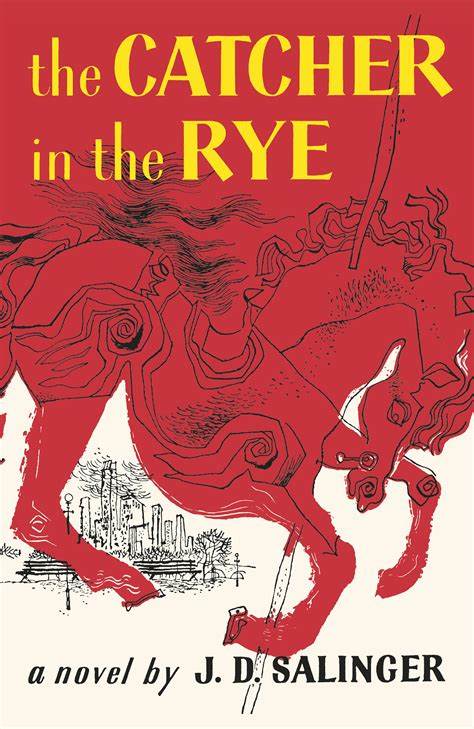
8. The Catcher in the Rye
“The Catcher in the Rye” is a classic novel written by J.D. Salinger and was first published in 1951. It is often considered one of the most influential works of American literature of the 20th century
1. Coming-of-Age Story: The novel is a coming-of-age story that follows the experiences of its protagonist, Holden Caulfield, over a few days in his life. Holden is a 16-year-old boy who has been expelled from an elite prep school and is wandering the streets of New York City.
2. Alienation and Disillusionment: Holden Caulfield is a deeply alienated and disillusioned character. He is critical of the phoniness and hypocrisy he perceives in the adult world and struggles to find authenticity and meaning in his own life.
3. Holden’s Voice: The novel is narrated in the first person by Holden himself, and his distinctive voice and language have become iconic in American literature. His cynical and often sarcastic tone reflects his view of the world around him.
4. The Red Hat: One of the novel’s most recognizable symbols is Holden’s red hunting hat. He uses it to shield himself from the world and sees it as a symbol of his individuality and defiance against conformity.
5. The Loss of Innocence: Holden is obsessed with preserving the innocence of children, particularly his younger sister, Phoebe. He imagines himself as the “catcher in the rye,” a guardian who saves children from falling into the corrupting influences of adulthood.
6. Themes of Loneliness and Isolation: Holden’s journey through the novel is marked by his feelings of loneliness and isolation. He struggles to connect with others and often pushes people away.
7. Holden’s Relationships: Throughout the novel, Holden interacts with various characters, including his little sister Phoebe, his former girlfriend Jane Gallagher, and a kind-hearted prostitute named Sunny. These interactions shed light on his complex personality and emotional struggles.
8. Rebellion and Nonconformity: Holden’s refusal to conform to societal expectations and his disdain for authority figures are central themes. He often rebels against the rules and conventions that he believes are phony.
9. Controversy and Banning: “The Catcher in the Rye” has been the subject of controversy and censorship due to its use of profanity and discussions of adult themes. Nevertheless, it remains widely taught in schools and celebrated for its literary significance.
10. Impact on Literature: The novel has had a profound impact on American literature and culture. It is frequently studied for its exploration of adolescent angst, identity, and the struggle to find one’s place in a world that can seem hypocritical and alienating.
“The Catcher in the Rye” continues to be a widely read and discussed work, and Holden Caulfield’s voice remains a symbol of youthful rebellion and the search for authenticity in an often complex and confusing world.

9. The Diary of a Young Girl
“The Diary of a Young Girl,” also known as “The Diary of Anne Frank,” is a poignant and powerful book written by Anne Frank, a Jewish teenager, during World War II. Anne received a diary as a gift for her 13th birthday, and she began writing in it on June 12, 1942, shortly before her family went into hiding to escape Nazi persecution.
1. The Holocaust and Persecution: The diary provides a firsthand account of the Holocaust and the persecution of Jews during World War II. Anne and her family, along with another Jewish family, the Van Daans, hid in a secret annex in Amsterdam to avoid capture by the Nazis.
2. Personal Reflections: Anne Frank’s diary is a deeply personal and intimate record of her thoughts, feelings, hopes, and fears during the two years she spent in hiding. It captures the inner world of a young girl coming of age under extraordinary circumstances.
3. Literary Talent: Anne Frank’s writing talent is evident throughout the diary. She possessed a gift for storytelling and a keen observational eye, which she used to describe the daily life and tensions in the annex.
4. Universal Themes: Although Anne’s diary is set against the backdrop of the Holocaust, it touches on universal themes of adolescence, family dynamics, friendship, and the search for identity. Her experiences are relatable to readers of all ages and backgrounds.
5. Anne’s Development: The diary chronicles Anne’s emotional and intellectual growth as she matures from a somewhat naive and spirited teenager into a reflective and introspective young woman.
6. Loss and Hope: Anne’s writings reflect the profound loss experienced by those in hiding, as well as her unwavering hope for a better future. Her famous line, “I still believe, in spite of everything, that people are truly good at heart,” exemplifies her enduring optimism.
7. Posthumous Publication: Tragically, Anne Frank did not survive the Holocaust. She and her sister, Margot, were eventually discovered by the Nazis and deported to concentration camps. Anne died in Bergen-Belsen concentration camp in early 1945. Her father, Otto Frank, the family’s only survivor, published her diary after the war.
8. Impact and Legacy: “The Diary of a Young Girl” has been translated into numerous languages and has touched the hearts of millions of readers worldwide. It has become a symbol of the human capacity for resilience, hope, and the enduring importance of bearing witness to history.
9. Anne Frank House: The annex where Anne and her family hid has been turned into the Anne Frank House in Amsterdam, a museum and educational center dedicated to her memory and the memory of all Holocaust victims.
Anne Frank’s diary remains an important work of literature and a testament to the strength of the human spirit in the face of adversity. It serves as a reminder of the atrocities of the Holocaust and the need to remember and learn from history to prevent such horrors from happening again.

10. The Book Thief
“The Book Thief” is a novel written by Markus Zusak, first published in 2005. It is a unique and emotionally powerful story set in Nazi Germany during World War II.
1. Narration by Death: One of the most distinctive features of the novel is its narrator, who is Death personified. Death tells the story and offers observations about the characters and events. This unusual perspective provides a thought-provoking and haunting backdrop to the narrative.
2. Liesel Meminger: The novel’s central character is Liesel Meminger, a young girl who is sent to live with a foster family in the fictional town of Molching. Liesel is known as “the book thief” because she develops a deep love for books and begins stealing them to read and share with others.
3. The Power of Words: “The Book Thief” explores the profound impact of words and storytelling. Liesel’s relationship with words and books serves as a means of comfort, escape, and connection with others during a tumultuous time.
4. The Importance of Human Connections: The novel highlights the value of human connections and the bonds that form between Liesel and her foster parents, her best friend Rudy, and a Jewish refugee named Max, whom the family hides in their basement.
5. Survival and Resilience: Against the backdrop of Nazi Germany and the horrors of war, the characters in the novel demonstrate resilience and the will to survive. They find solace and strength in each other and their shared love for literature.
6. Small Acts of Defiance: Throughout the story, characters engage in small acts of defiance against the oppressive regime. These acts of resistance, whether through reading forbidden books or providing shelter to those in need, are portrayed as meaningful and courageous.
7. Illustrations and Typography: The novel includes unique visual elements, such as illustrations and typography, which enhance the reading experience and contribute to the book’s artistic and thematic depth.
8. Themes of Loss and Grief: “The Book Thief” does not shy away from the realities of loss and grief during wartime. The characters grapple with the death of loved ones and the emotional toll of living in a world filled with uncertainty.
9. Humanity Amidst Inhumanity: The novel portrays the contrasting aspects of humanity—both the capacity for cruelty and the capacity for kindness. It emphasizes the importance of preserving one’s humanity in the face of inhumanity.
10. The Impact of Literature: The story underscores how literature can be a source of comfort, empathy, and hope during even the darkest times. It celebrates the transformative power of storytelling.
“The Book Thief” is a beautifully written and thought-provoking novel that resonates with readers due to its exploration of universal themes such as love, loss, resilience, and the enduring power of words. It has received critical acclaim and has been widely read and studied, making it a modern classic in contemporary literature.
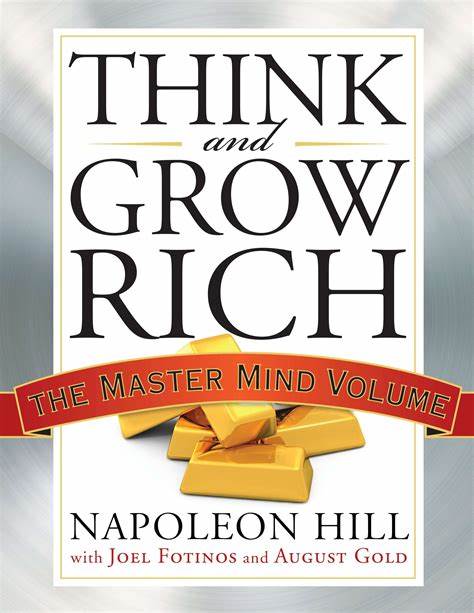
11. Think and Grow Rich
“Think and Grow Rich” is a classic self-help book written by Napoleon Hill and first published in 1937. It is one of the most influential and enduring books in the personal development and success literature genre.
1. The Power of Positive Thinking: “Think and Grow Rich” emphasizes the power of a positive mental attitude. And the impact of one’s thoughts and beliefs on their success and well-being. Hill argues that success begins with a state of mind.
2. The 13 Principles of Success: The book outlines 13 key principles that, when applied, can lead to wealth and success. These principles include desire, faith, persistence, specialized knowledge, and cooperation, among others.
3. Definiteness of Purpose: Hill emphasizes the importance of having a clear and definite goal or purpose in life. He argues that having a strong and unwavering desire to achieve a specific goal is a critical step toward success.
4. Visualization: The book encourages readers to visualize their goals and dreams as a way to create a mental blueprint for success. Hill believes that visualization can help individuals align their thoughts and actions with their desired outcomes.
5. The Mastermind Principle: Hill introduces the concept of the “mastermind alliance”. Which involves surrounding oneself with a group of like-minded individuals. These like-minded people can provide support, guidance, and inspiration on the path to success.
6. Overcoming Fear: Hill explores the role of fear in holding individuals back from achieving their goals. He provides strategies for overcoming fear and developing the courage to take action.
7. Persistence and Resilience: Hill emphasizes the importance of persistence in the face of adversity and setbacks. He argues that most successful people face numerous challenges before achieving their goals.
7. Riches Beyond Money: This book also emphasizes that true riches can extend beyond money and material possessions to include happiness, health, and fulfilling relationships.
8. Case Studies: Throughout the book, Hill provides examples of successful individuals who have applied his principles to achieve greatness. These real-life stories illustrate the practical application of his ideas.
9. Continued Influence: “Think and Grow Rich” has had a profound and enduring impact on the self-help and personal development industry. It has inspired countless individuals to pursue their dreams, set goals, and take positive action in their lives.
Napoleon Hill’s “Think and Grow Rich” continues to be a widely read and respected book in the field of personal development.
Its timeless principles and practical advice on achieving success, combined with Hill’s inspirational storytelling, have made it a classic that continues to inspire and motivate readers to this day.
12. Conclusion
We believe that the article “The Most Inspiring Books of All Time” will give you more insight into life and challenges. Reading inspiring books influences our perception towards our way of life.
Inspiring books can help to cultivate a more positive and optimistic mindset. They often focus on the potential for personal growth and transformation, which can help you develop a more hopeful outlook on life.
More interesting reads
